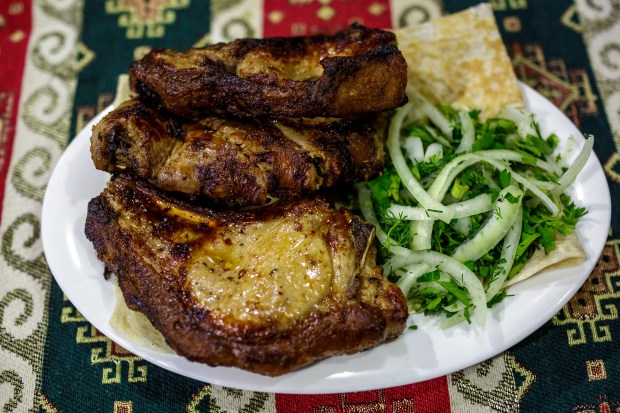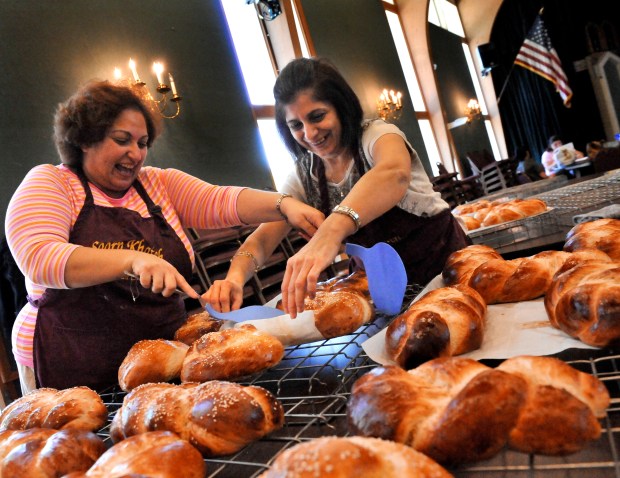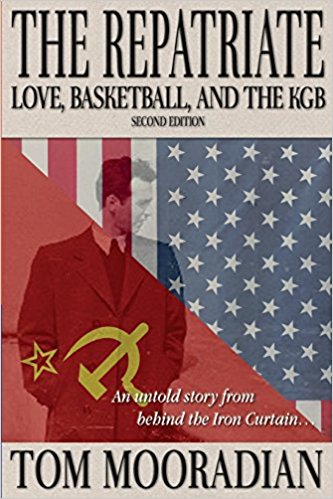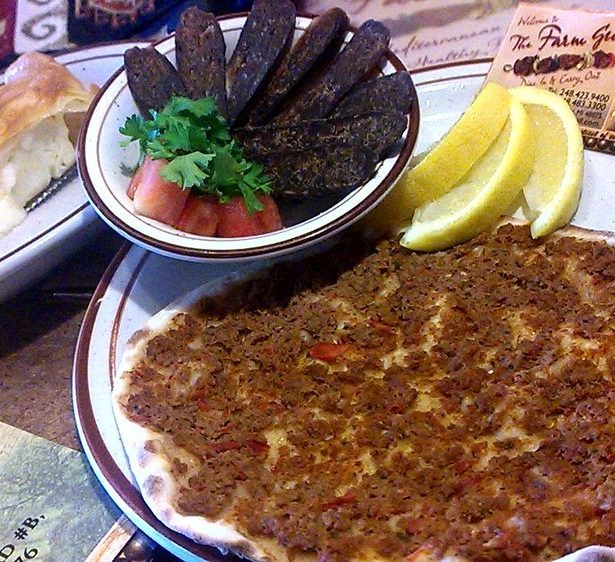In 1972, Levon Avdoyan moved from the U.S. to what was then Soviet Armenia to study for his Ph.D. in the country’s repository of ancient manuscripts. Along with a change in scenery, political system, and language, he found a vastly different kind of Armenian food from what he grew up with in Providence, Rhode Island.
“It was then that I realized that Armenian food in the Caucasus was basically different from the Armenian cuisine in historical Armenia,” he says.
Avdoyan, whose family hailed from the ancient city of Kharpert (in present-day Turkey), grew up eating his grandmother’s pilaf, stuffed grape leaves, homemade yogurt, and a lamb and bulgur meatball dish called kharpert kufta.
In Armenia, those delicacies were nowhere to be found. Instead, he encountered Soviet cuisine with occasional glimpses of traditional eastern Armenian food. He ate a lot of potatoes and borscht, and on special occasions like New Year’s Day he indulged in pasus dolma (pickled cabbage leaves stuffed with chickpeas, lentils, and spices).
Food is a constant topic of discussion for Armenians, who often disagree on and debate what cuisines and dishes are authentically Armenian.

That’s because the definition of Armenian food changes, depending on the people you ask and where they’re from. What’s eaten in Armenia is vastly different from what constitutes Armenian cuisine outside the country—from ingredients and dishes to the names and pronunciations of foods and when they are eaten. Even something as simple as barbecue varies when it comes to the kind of meat used (pork in Armenia versus lamb or beef in the diaspora) and what cooking it over an open fire is called (khorovats versus shish kebab).
Gegham Mughnetsyan, who immigrated to the U.S. from the Republic of Armenia in 2006 at age 15, faced a similar shock in reverse.
At an Armenian youth camp in Fresno, Calif., he was introduced to choreg, a sweet bread made with the aromatic ground seeds of sour cherries. It is one of the more cherished dishes of the Armenians of the diaspora, who have made it at home and in church cooking groups for generations.
Born in Gyumri, Armenia’s second-largest city, Mughnetsyan had never heard of—much less eaten—choreg.
“They said, ‘What kind of Armenian are you that you’ve never had choreg?’” he recalls.

The Armenian genocide of 1915, in which 1.5 million Armenians were killed by the Ottoman government, set in motion a global diaspora. (Turkey continues to deny that a genocide took place.)
Survivors spread across the world, from California to Australia, taking their food traditions with them. Armenians who settled in larger numbers in countries like Syria, Lebanon, and Iran contributed to and incorporated the dishes of their new nations. They introduced things like basterma (air-cured, heavily spiced beef) and eetch (an appetizer made of ground bulgur, tomato paste, and parsley). In turn, dishes like hummus and ful mudammas (cooked and seasoned fava beans) made their way onto the Armenian table.
Eastern Armenia, which was part of the Persian Empire from the 16th to 19th centuries, was absorbed into the Soviet Union, becoming the Armenian Soviet Socialist Republic in 1920.
Soviet cuisine, an amalgamation of food from Russia, Uzbekistan, Georgia, and other countries in the union, permeated Armenia, and its residents were introduced to chicken Kiev, Olivier salad, and Napoleon torte.
The industrialization of food supplies had an impact too. Farms were collectivized, and large-scale pork production was introduced. Village food and life disappeared as many moved to urban areas, where meats and vegetables were canned. Still, some traditions like harissa—a thick porridge made of meat and cracked wheat shared by all Armenians—continued to be made whenever possible.
Differences between Armenian food in and outside Armenia first became very apparent during the post–World War II repatriation movement, in which over 100,000 Armenians of the diaspora heeded a call to return home under a Soviet repopulation plan.
Tom Mooradian was one of them.

Born and raised in Detroit, Mooradian is the son of an Armenian genocide survivor. He says his childhood was filled with western Armenian dishes like chicken and pilaf—a simple, classic diaspora dish made of bulgur or long-grain rice, chicken stock, and toasted vermicelli.
When he moved to Soviet Armenia, at 18, he found piroshkis (fried buns stuffed with meat or potato) instead of the meals he’d grown up with. What he remembers most about food from this period, however, was the lack of it, as the Soviet Union was prone to food shortages.
“During my time, we basically had nothing,” he says. “So it was very difficult to put a meal on the table.”
To understand the confusion means exploring Armenia and Armenians’ complicated history of wars, genocide, kingdoms, and conquerors.
Armenian food traditions were created over thousands of years in a swath of land known as the Armenian highlands, which in addition to the Republic of Armenia, covered a region including parts of other surrounding countries, like modern-day Iran, Turkey, and Iraq. The region’s rugged but fertile geography was well suited to growing wheat, rice, lentils, figs, pistachios, and apricots, shaping distinct regional delicacies, flavors, and variations. Its location, wedged between major powers, made it a prime place for battles amongst different empires, including the Byzantine, Persian, Russian, and Ottoman.
The western highlands fell under Ottoman rule for more than 400 years (until the empire was dissolved in 1922 and subsequently became modern-day Turkey), causing Armenian food traditions to evolve in a multiethnic empire that included Greeks, Assyrians, Turks, Jews, Kurds, Bulgarians, and Bosnians.

Mooradian spent 13 years in Soviet Armenia, which he documents in his 2008 book, The Repatriate: Love, Basketball, and the KGB.
“I don’t think culture is static. Culture always changes,” says Lena Osipova-Stocker, who was born in Yerevan, Armenia’s capital, to parents from Lebanon and Ukraine. “Food is one of those things about culture that is the easiest to transform and change.”
Her childhood was filled with a mixture of Soviet Armenian food and the culinary traditions her mother and grandmother brought from Anatolia and Lebanon.
“You had all these waves of foods that they called Armenian that people would bring with them, and there would be a little bit of a clash,” she says. “At that point, people would realize, ‘Oh, what I’m calling Armenian is not what you are calling Armenian.”
Osipova-Stocker thought she knew the distinctions between western and eastern Armenian food. But when she went to school in Cyprus and met Cypriot-Armenians whose forebears fled from cities like Adana during the genocide, she realized even western Armenian food varied greatly.
World events over last 40 years have further affected Armenian cuisine. The civil war in Lebanon, the revolution in Iran, and the dissolution of Soviet Armenia sent more waves of Armenian refugees to the U.S., where Armenians from different regions mingled, tried one another’s cuisines, and of course argued about which was more Armenian than the others.
Armenian food culture continues to change.
In Armenia an influx of Armenian refugees from Syria escaping civil war have opened popular restaurants in Yerevan, where they serve open-faced meat pies called lahmajun and Middle Eastern Armenian specialties like lamb kebab with sweet and sour cherries.

And in the U.S., Yerevan emigres in Los Angeles, which has the largest population of Armenian-Americans, have popularized ponchiks, doughnuts that were popular in the Soviet Union, filling them with Nutella and Oreos. In Detroit, Hasmik Movsesyan and her daughter Anahit Movsesyan have adapted to the tastes of the deeply rooted Armenian-American community that has had a presence in the Midwest for over a century. Hasmik Movsesyan, who grew up in Yerevan, owns the Farm Grill, a restaurant in Southfield, Michigan. It’s the only restaurant in the state where you can find western Armenian dishes like manti (baked lamb dumplings served with yogurt) and su boreg (a boiled phyllo dish that the Movsesyans now make with Wisconsin brick cheese).
“When you come to Detroit and you see the descendants of Armenians from the genocide, they worship their Armenian food. It’s amazing,” says Hasmik Movsesyan. “When you can do something like that in a town like this, you get happy, because no one else is doing it.”
As social media deepens connections between Armenian residents and the diaspora, different generations of Armenians are becoming familiar with one another, for example through Armenian cooking groups on Facebook.
“The root of all problems is people not knowing each other and not reaching out to know each other,” says Gegham Mughnetsyan, adding that the diaspora, with all its various internal factions, is eagerly learning about itself too. “People are hungry for this information.”